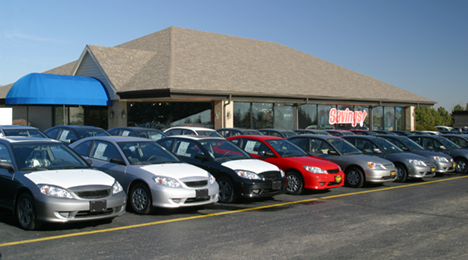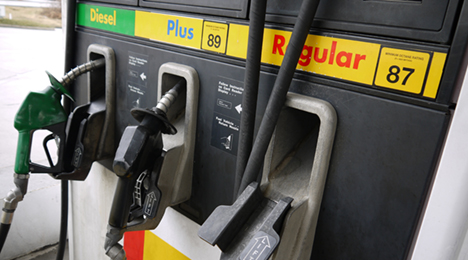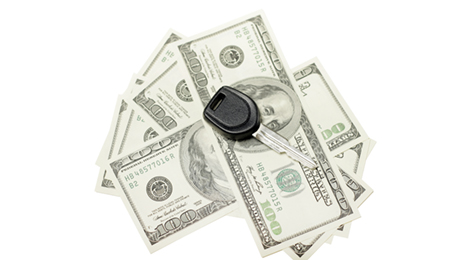KAR Auction Services chief executive officer Jim Hallett is bullish about the prospects for independent dealerships — not only for their retail performance, but also on the potential for these stores to acquire highly desirable off-lease vehicles coming down ADESA’s lanes.
Hallett made his assertions earlier this week when KAR released its first-quarter financial report. He referenced data from CNW Research that indicated independent stores sold more than 1 million vehicles in March alone, and their first-quarter retail sales total climbed 4.8 percent year-over-year, more than what was generated by franchised dealers and private-party transactions combined.
“We hear a lot about the franchise dealers and the number of (certified pre-owned) sales that are taking place,” Hallett said. “I would point out that let’s not take our eye off the independent used-car dealers.”
Hallett continued to reference independent dealers when he mentioned growing off-lease volume, which the company thinks will steadily rise as the year unfolds. He thinks that volume will expand to a point where not all off-lease units will end up either at the grounding dealership or in private-label sales available only to franchised stores.
“We spent considerable time talking about the increased supply causing more off-lease vehicles to get to the physical auction, and we do expect that this will occur throughout the balance of the year for a couple reasons I’d like to point out,” Hallett said.
“No. 1, we’ve said that franchise dealers won’t be able to handle all of the volume that’s coming their way,” he continued. “And I want to make sure that we understand that I’m not suggesting for a minute that the franchise dealers aren’t going to buy as many of these cars as they have in the past. In fact, I could suggest that they may even buy more of these vehicles.
“But when you look at the total number of vehicles that are going to arrive off-lease, I believe that, ultimately, these franchise dealers will reach a capacity where these vehicles will eventually make their way to the physical auction,” Hallett added.
The KAR boss explained his other reason was connected to ADESA’s Tom Kontos and other industry experts projecting that end-of-lease residual values will exceed market values for the foreseeable future.
“I think that more of these dealers will pass the car at the point of being grounded to the point that they will go into the funnel. And as they work their way through the funnel, more will eventually get to the physical auction,” Hallett said. “So with that said, I think we'll just have to wait and see how that plays out over the next few months.”
And what might happen during those next few months could be positive for dealerships, especially independent stores, according to Hallett.
“The franchise dealers that population isn’t growing. There’s only so many franchise dealers in the country. I believe that they can only handle so much volume, and at some point, they reach capacity,” Hallett said.
“As you know, those cars go into the closed environments first, and that’s where your franchise dealer primarily buys these vehicles,” he continued. “Then I think what will happen is those cars are going to going to the open online sales. When you go to the open line online sale, you go from just those franchise dealers and you add 37,000, 38,000 independent dealers who are now eligible to buy those cars in an open online sale.
“Then obviously, when you get to the physical auction, again, that vehicle is now available to all those independent dealers, as well. So that's a long way of confirming that, yes, I see more independent dealers getting to more of these off-lease vehicles,” Hallett went on to say.
So when should independent dealers who use ADESA auctions begin to see more off-lease vehicles in the lanes?
“I think the indication is going to come here in the next 60 days or so that we’ll start to see what percentage eventually makes their way to physical and what percentage are being bought by independents,” Hallett said. “I do believe that once these vehicles do get to the physical auctions, there will be a higher percentage of those vehicles being bought at the physical auctions by the independent dealer.”
Wholesale prices are continuing to correct after experiencing seasonal highs earlier this spring.
Using its AuctionNet data and analysis, NADA Used Car Guide is predicting prices to fall by 0.4 percent or $75 this week.
And only one segment is expected to see prices lift: midsize vans, which are predicted to see price gains of 0.3 percent, or $50.
The majority of segments will see prices drop, led by the compact utility segment, with average declines of 0.9 percent, or $150.
The midsize utility and midsize car segments will follow with predicted declines of 0.8 percent and 0.7 percent, respectively.
Seeing slighter declines this week are the compact and luxury segments as prices are expected to slip by 0.6 percent, according to NADA UCG data.
Lastly, large pickups and SUVs are each expected to see declines of around 0.2 percent, followed by luxury utilities at 0.1 percent.
One can only wonder if these larger units may see bigger price declines in the near future, as gas prices are a bit inflated, sitting at $3.68 per gallon, according to Energy Information Administration data.
These price drops continue trends seen in the lanes last week, as Black Book’s Ricky Beggs reported Monday.
Though 54 percent of the overall price changes in the lanes last week were still increases, this number was the lowest percentage of increases since the week of March 14, the Black Book editorial director and senior vice president noted in his latest “Beggs on the Used Car Market” video report.
Commenting on dealer response in the lanes last week, Beggs said, “A sign of tax season being behind us was supported with a comment about the ‘budget cars are down.’ The comment that really said it all was that we just had a ‘regular end of the month sale.’”
This past week, only four of the 10 car segments saw prices increase at auction. For more from Black Book on last week’s price movement, click here.
Four- and two-week AuctionNet wholesale average prices are created by collecting all AuctionNet records for vehicles up to five years of age for a specified period of time. Prices are then adjusted for changes in mileage and mix.
Current week prices are based on NADA's proprietary used-vehicle value model which includes assumptions for new-vehicle prices, used vehicle supply, gasoline prices and other economic factors.

| NADA Segment |
Average AuctionNet® Wholesale Price |
2-Week v. Current |
| 4-Week Average |
2-Week Average |
Current Week |
% Change |
$ Change |
| Compact Car |
$11,750 |
$11,700 |
$11,625 |
-0.6% |
($75) |
| Compact Utility |
$16,250 |
$16,125 |
$15,975 |
-0.9% |
($150) |
| Industry |
$17,075 |
$16,950 |
$16,875 |
-0.4% |
($75) |
| Large Pickup |
$23,575 |
$23,550 |
$23,500 |
-0.2% |
($50) |
| Large SUV |
$30,425 |
$30,200 |
$30,125 |
-0.2% |
($75) |
| Luxury Car |
$23,450 |
$23,425 |
$23,275 |
-0.6% |
($150) |
| Luxury Utility |
$27,500 |
$27,550 |
$27,525 |
-0.1% |
($25) |
| Mid-Size Car |
$13,550 |
$13,475 |
$13,375 |
-0.7% |
($100) |
| Mid-Size Utility |
$20,825 |
$20,675 |
$20,500 |
-0.8% |
($175) |
| Mid-Size Van |
$16,925 |
$16,925 |
$16,975 |
0.3% |
$50 |
As May rolled in last week, Black Book’s Ricky Beggs says it brought with it the end of the peak of spring used-car activity and overall strength of auction prices.
Though 54 percent of the overall price changes in the lanes last week were still increases, this number was the lowest percentage of increases since the week of March 14, the Black Book editorial director and senior vice president noted in his latest “Beggs on the Used Car Market” video report.
Commenting on dealer response in the lanes last week, Beggs said, “A sign of tax season being behind us was supported with a comment about the ‘budget cars are down.’ The comment that really said it all was that we just had a ‘regular end of the month sale.’”
This past week, only four of the 10 car segments saw prices increase at auction.
Near luxury cars joined the three segments that have seen prices rise every week for the past nine weeks: the entry midsize cars, the compact cars and the upper midsize cars.
Overall, the car segments finished with an average decline of $3. Beggs pointed out this shows year-over-year strength, as cars fell by an average of $39 during the same week last year.
The truck segments are seeing stronger price retention in the lanes, rising by an average of $9 last week. Last year, the truck segments saw an average drop of $1 during the same period.
“The interesting point is even with the small level of overall increase, there were still 12 of the 14 truck segments that were increases, but five of those 12 were increases of only $6 or less,” Beggs reported
As far as declines go, the midsize SUVs saw a slight drop of $8, which was the first negative result for this segment in seven weeks.
Lastly, luxury SUVs saw a drop of $90.
Beggs also pointed out another interesting trend to keep an eye on.
For the second straight week, gas prices rose by $0.03. This marks a $0.38 increase from where rates were at the beginning of the year, bringing the average to $3.71.
“We will be watching to see if gas increases again, and to whether it is at a level that could have an effect on various segments of the market,” Beggs said.
Though diesel vehicles might not be considered environmentally friendly by all, the bottom line is, they are more fuel-efficient than there gasoline counterparts.
And as fuel efficiency becomes more and more of a concern for shoppers, the Environmental Protection Agency said that diesel vehicles are making a bit of a comeback in the U.S. after years of poor sales and meagre product offerings.
Analysis from NADA Used Car Guide suggests that although diesel rides are some of the most efficient on the market, their high price tags can be a bit of a determent.
“While diesels are more fuel efficient and generally earn higher used retention scores, costs can be substantially more up front, and the widening spread between diesel and gasoline prices — which went from 11 cents in 2009 to 42 cents in 2013 — mean that fuel savings may not be as great as they once were,” theNADA UCG analysis indicates.
To determine whether diesel vehicles are worth the higher premium, NADA UCG compared two different 3-year-old vehicles and their respective diesel counterparts: the Volkswagen Jetta and Mercedes-Benz ML350.
Analysts looked at each model’s combined MPG, new typically equipped MSRP, April 2014 average trade-in value and retention after three years of ownership versus similarly equipped gasoline models.
They came up with a few points that may point toward stronger diesel sales in the future.
First, when NADA UCG examined the diesel Jetta and ML350, the models beat out their gasoline counterparts in every category except for carrying higher new equipped MSRPs.
“While each diesel model was more expensive up front, the extra outlay of money appears to be well worth it after three years of depreciation,” NADA UCG reported.
For example, the Jetta was $3,584 more expensive than the gasoline version. But there’s a caveat.
According to NADA UCG’s Average Trade-in Values from April, the gap between values has expanded to $3,925 in favor of the diesel.
NADA UCG found that retention was stronger among the diesel models. The Jetta TDI retained 60.1 percent of its original value after three years of depreciation, while the gasoline-only SE model retained 51.6 percent.
The same situation was found for the ML350. When new, the diesel version costs $910 more than a similarly equipped gasoline model, but current trade-in values show that this spread has increased to $3,400 in favor of the diesel.
After three years, the ML350 BlueTEC 4MATIC retained 52.3 percent of its original value, while the gasoline-only ML350 4MATIC has retained 47.1 percent.
Another argument many use as a deterrent to diesel vehicles is the higher cost of diesel fuel.
But, in light of the fuel efficiency of some of these models, that isn’t so much of an issue.
The Jetta TDI annual fuel savings came in at $217, and the ML350 Blue TEC saves shoppers $571 a year, according to NADA UCG data.
These calculations were found when looking at average 2013 fuel cost associated with each model when driven 15,000 miles.
Wholesale prices are expected to continue dropping from tax-season highs.
In its AuctionNet price analysis sent Thursday, NADA Used Car Guide is predicting that this week's auction prices will end up dropping by an average of 0.3 percent, or $50.
While the compact car and midsize van segments are expected to “hold steady” over the course of the week, all other segments are expect to see slight declines, according to NADA UCG automotive analyst David Paris.
Leading the pack will be the midsize car segment, as prices are expected to slip by 0.6 percent ($75).
Large SUVs and compact utilities are also expected to drop, with 0.5-percent decreases each, following by luxury cars with a slightly smaller 0.4-percent drop.
The luxury and midsize utility segments are predicted to see a slight 0.2 percent loss.
Lastly, the large pickups, which have held strong price retention throughout the first quarter, are expected to see a price decline of 0.1 percent this week.
Four- and two-week AuctionNet wholesale average prices are created by collecting all AuctionNet records for vehicles up to five years of age for a specified period of time. Prices are then adjusted for changes in mileage and mix.
Current week prices are based on NADA's proprietary used-vehicle value model which includes assumptions for new-vehicle prices, used-vehicle supply, gasoline prices and other economic factors.

| NADA Segment |
Average AuctionNet® Wholesale Price |
2-Week v. Current |
| 4-Week Average |
2-Week Average |
Current Week |
% Change |
$ Change |
| NADA Segment |
$11,625 |
$11,600 |
$11,600 |
0.0% |
$0 |
| $16,300 |
$16,225 |
$16,150 |
-0.5% |
($75) |
| NADA Segment |
$17,150 |
$17,050 |
$17,000 |
-0.3% |
($50) |
| $23,775 |
$23,725 |
$23,750 |
0.1% |
$25 |
| NADA Segment |
$30,425 |
$30,375 |
$30,225 |
-0.5% |
($150) |
| $23,900 |
$23,800 |
$23,700 |
-0.4% |
($100) |
| NADA Segment |
$27,675 |
$27,625 |
$27,575 |
-0.2% |
($50) |
| $13,600 |
$13,575 |
$13,500 |
-0.6% |
($75) |
| NADA Segment |
$20,775 |
$20,775 |
$20,725 |
-0.2% |
($50) |
| $17,025 |
$16,975 |
$16,975 |
0.0% |
$0 |
Auction prices were still moving up in March as tax-season rate highs lingered a bit longer than usual, but the spike isn’t here to stay.
According to RVI’s first-quarter newsletter, prices increased by 2.5 percent from February and 4.8 percent year-over-year last month (after adjusting for MSRP, the price change is slightly less, with an increase of 2.2 percent from February and 1.7 percent year-over-year).
And though spring has seen auction prices remain high, they are predicted to decline slightly due to seasonality in the short-term, and RVI offered a long-term outlook, as well. Used-car prices are expected to begin declining in 2015, and by 2017, the company expects used-car prices to drop by 5 percent.
The midsize sedans have seen auction prices rise the most since February, according to RVI, with prices spiking by 3 percent within the segment.
But just as the overall industry price hikes are not predicted to stick around, neither is the spike within this segment.
“The supply of midsize sedans will continue to increase through 2018 and this increased supply will lead to a drop in used car prices for the segment,” RVI analysts reported. “By the end of 2017, used-car prices within the segment are expected to drop below 4 percent of current levels.”
This trend as well as overall industry predictions regarding upcoming used-price drops are in part due to the fact to an influx of off-lease vehicles expected to start flooding the market this year.
And lease penetration rates continue to rise, boding well for off-lease supply in the next three to five years, as well.
RVI noted that lease penetration “continues to grow and is expected to increase for 2014 and 2015 model-year vehicles.”
In fact, lease penetration increased in Q4 of 2013 to 24.1 percent of new-vehicle sales. RVI offered the following comparison: during the fourth quarter of 2012, the lease penetration rate as at 20.8 percent of retail sales.
As far as which brands are seeing the highest leasing rates, Infiniti leads the pack with a 61 percent lease penetration rate in Q4 2013.
Volkswagen has the highest lease penetration among non-luxury brands with a rate of 36 percent, according to RVI.
As wholesale prices begin to come down, pre-owned retail prices ticked up this month after remaining relatively consistent for most of the first quarter. But some of the pricier units bucked the trend, making up nine out of the top 10 vehicles that saw the biggest price drops in April.
According to a recent post on the Cars.com “Kicking Tires” blog written by Mike Hanley, luxury-car prices fell again this month, while mainstream models continued to see price hikes. The company notes that its lists include 2011 to 2013 model-year vehicles, and each eligible model must have at least 250 in the Cars.com national inventory.
The only mainstream brand unit to make the list of decliners was Hyundai’s full-size Equus sedan at No. 10, which is incedentially still considered a luxury vehicle.
Luxury models have made up the majority of cars in the top 10 every month so far this year, the Cars.com report noted.
Overall, used retail prices have risen by a slight 0.75 percent (or $175) this month to reach an average of $23,418, according to the site.
“The increase might be a reflection of more shopping activity as the spring selling season begins following a long, cold winter in many parts of the country,” Hanley wrote in the report.
Topping the list this month for biggest used-car price drops was the Land Rover Range Rover SUV, which saw prices fall by 4 percent (or $2,871).
Next up was the Audi A3, which fell by 3.1 percent (or $752), and the Mercedes-Benz CLS-Class, which saw a 2.9-percent (or $1,730) drop.
As for the models that saw the biggest price jumps, the results were much more varied.
The Chevrolet Express 1500 full-size van had the largest price hike with a 2.9-percent ($594) increase.
The GMC Sierra 3500 and Nissan Leaf, which were up 2.6 percent ($1,158) and 2.5 percent ($488), respectively, followed closely behind.
To view the full charts detailing which cars of seen the biggest price spikes and drops this month, see the Cars.com blog post here.
Black Book Analysis on Wholesale Trending
On the wholesale side of the market, this past week was an interesting divide between car and truck segments, which were moving in opposite directions. Overall, the market seems to be approaching some stability.
In a bit of analysis provided exclusively to Auto Remarketing on Monday, Black Book editorial director Ricky Beggs said that the market has apparently met the pent-up demand for the spring season, which should lead to some moderation in pricing.
For instance, Black Book had been seeing an average of more than 2,000 daily vehicle price adjustments, but that was trimmed to roughly 1,350 per day last week.
Breaking down the week’s changes in more detail, the truck segments, overall, were up $73, with 13 of the 14 categories showing positive movement. The luxury SUV class was the only one to decrease.
As for cars, their overall change was a downward movement of $13, which Beggs said marked the first time in five weeks cars have shown an overall negative change.
In his weekly video report on the used-car market, Beggs talked with the leadership of the International Automobile Remarketers Alliance. More on that interview can be found here. Black Book also announced a partnership with Cars.com on Monday. To learn more details, read Auto Remarketing's story on the deal.
After holding strong and steady last week, auction prices are expected to begin their usual late spring decline.
This week, NADA Used Car Guide is predicting auction prices to fall by an average of 0.3 percent, or $50.
This will bring the average wholesale price down to a still strong $17,225.
Most weeks so far this spring have seen price hikes across the board among car and struck segments, but this week only two segments are expected to see rises at all.
According to NADA UCG, compact cars and utilities are predicted to see gains of 0.4 and 0.2 percent, respectively.
The biggest losses this week are expected among the larger vehicles.
First up, the largest percentage drop will be the midsize van segment, as prices are expected to fall 0.9 percent, or $150.
The large SUVs will likley follow, falling by 0.7 percent, or $200.
All remaining segments are expected to fall within a tight range of 0.1 percent to 0.5 percent, reported David Paris, automotive analyst at NADA UCG.
This may be the week that turns the tides, as Black Book was still reporting price gains when recording last week’s results.
Last week, both the car and truck segment prices increased again — bringing rate spikes to four straight weeks for the cars and five consecutive weeks for the trucks, according to Black Book.
Almost all truck segments saw price hikes (13 out of the 14 segments Black Book tracks) increased, for an average price rise of $34.
The only segment to decrease last week, according to Black Book data, was the luxury SUVs, which only fell by $2.
Four- and two-week AuctionNet wholesale average prices are created by collecting all AuctionNet records for vehicles up to five years of age for a specified period of time. Prices are then adjusted for changes in mileage and mix.
Current week prices are based on NADA's proprietary used-vehicle value model which includes assumptions for new-vehicle prices, used-vehicle supply, gasoline prices, and other economic factors.

| NADA Segment |
Average AuctionNet® Wholesale Price |
2-Week v. Current |
| 4-Week Average |
2-Week Average |
Current Week |
% Change |
$ Change |
| Compact Car |
$11,650 |
$11,700 |
$11,750 |
0.4% |
$50 |
| Compact Utility |
$16,450 |
$16,400 |
$16,425 |
0.2% |
$25 |
| Industry |
$17,300 |
$17,275 |
$17,225 |
-0.3% |
($50) |
| Large Pickup |
$23,825 |
$23,850 |
$23,800 |
-0.2% |
($50) |
| Large SUV |
$30,775 |
$30,375 |
$30,175 |
-0.7% |
($200) |
| Luxury Car |
$24,050 |
$24,050 |
$23,925 |
-0.5% |
($125) |
| Luxury Utility |
$27,700 |
$27,775 |
$27,725 |
-0.2% |
($50) |
| Mid-Size Car |
$13,650 |
$13,650 |
$13,600 |
-0.4% |
($50) |
| Mid-Size Utility |
$20,750 |
$20,875 |
$20,850 |
-0.1% |
($25) |
| Mid-Size Van |
$17,150 |
$17,100 |
$16,950 |
-0.9% |
($150) |
Though prices in the lanes seemed to be evening out after tax season spikes, rates started ascending once again last week.
Black Book’s Ricky Beggs explained this unusually long spring market is likely due to the tougher winter weather the industry experienced this year.
As a result, spring market strength started a bit later and will likely stick around long than usual.
“There is no doubt the strength in the market values and activity from the second week of March to this past week has brought some amazing levels of changes in the values. Now we may be starting to see a ‘more steady’ market,” said Beggs, Black Book editorial director and senior vice president in his latest “Beggs on the Used Car Market” video report.
Both the car and truck segment prices increase again — bringing rate spikes to four straight weeks for the cars and five consecutive weeks for the trucks.
Almost all truck segments saw price hikes (13 out of the 14 segments Black Book tracks) increased, for an average price rise of $34.
The only segment to decrease last week was the luxury SUVs, which only fell by $2.
“We now have six segments that have increased for at least six consecutive weeks with the compact crossovers positive week over week for seven weeks running,” said Beggs. “The truck based compact SUVs at +$71 has been the strongest change levels for three of the past four weeks.”
For the cars, half of the segments Black Book tracks saw price hikes this past week.
The full-size cars saw the biggest increase, rising by $78 last week.
And both mid-size car segments continued their strength, rising $34 each.
The decline in value of the premium sporty cars of $50 was the lowest weekly change over the past seven weeks for this segment.
“Does this mean spring time is finally here?” Beggs asked during the video report.
The entry-level cars also ended their “streak” of price increases, Beggs said, with average prices falling by $1 last week.
“We look forward to getting back on the lanes again this week to see if the positive changes continue or if those comments of a more steady market prevail,” Beggs concluded.
After Black Book reported wholesale prices were returning to normal earlier this week, NADA Used Car Guide reinforced that assertion as it predicts wholesale prices will fall by 0.3 percent or $50, after seeing large price hikes in March.
The slight decline will bring the average industry price down to $17,225 by the end of this week, according to NADA UCG.
Only two segments are expected to see gains this week.
The compact cars will lead the increases with a gain of 0.4 percent, and utilities are expected to follow with a 0.2 percent spike.
On the other hand, the biggest drops are expected in the mid-size van segment, with a 0.9 percent or $150 slide.
As spring gets underway, demand for large SUVs is falling, and the segment is predicted to drop by 0.7 percent or $200.
All remaining segments are expected to fall within a tight range of 0.1 percent to 0.5 percent, according to David Paris, automotive analyst at NADA UCG.
And If last week’s price movement is any indicator, spikes in wholesale prices may finally be slowing down as Tuesday marked the IRS tax filing deadline.
Wholesale prices rose 6 percent in March on a monthly basis and 4 percent from the same period last year, averaging $10,429, according to ADESA Analytical Services’ data. But rates might just be getting back to normal.
Though the auction market is still holding strong overall, this past week marked the lowest level of price increases in the past four weeks, according to Black Book’s Ricky Beggs, who reported that 62 percent of rate changes were increases.
This is very much in line with what Black Book has heard from the lanes, including comment like “good but not as strong as last month” from the Texas market to go along with “steady again” out of Illinois and the “still high” all the way from Washington state, the Black Book editorial director reported in his latest “Beggs on the Used Car Market” video report.
Four- and two-week AuctionNet wholesale average prices are created by collecting all AuctionNet records for vehicles up to five years of age for a specified period of time. Prices are then adjusted for changes in mileage and mix.
Current week prices are based on NADA's proprietary used vehicle value model which includes assumptions for new vehicle prices, used vehicle supply, gasoline prices, and other economic factors.

| NADA Segment |
Average AuctionNet® Wholesale Price |
2-Week v. Current |
| 4-Week Average |
2-Week Average |
Current Week |
% Change |
$ Change |
| Compact Car |
$11,650 |
$11,700 |
$11,750 |
0.4% |
$50 |
| Compact Utility |
$16,450 |
$16,400 |
$16,425 |
0.2% |
$25 |
| Industry |
$17,300 |
$17,275 |
$17,225 |
-0.3% |
($50) |
| Large Pickup |
$23,825 |
$23,850 |
$23,800 |
-0.2% |
($50) |
| Large SUV |
$30,775 |
$30,375 |
$30,175 |
-0.7% |
($200) |
| Luxury Car |
$24,050 |
$24,050 |
$23,925 |
-0.5% |
($125) |
| Luxury Utility |
$27,700 |
$27,775 |
$27,725 |
-0.2% |
($50) |
| Mid-Size Car |
$13,650 |
$13,650 |
$13,600 |
-0.4% |
($50) |
| Mid-Size Utility |
$20,750 |
$20,875 |
$20,850 |
-0.1% |
($25) |
| Mid-Size Van |
$17,150 |
$17,100 |
$16,950 |
-0.9% |
($150) |













